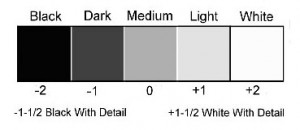Tone Chart and Exposure
You can use the tone chart below to help you determine the tones of the subjects you find in nature. Once you develop the ability to read tones, you will be able to understand when and if you need to adjust the camera’s “correct” exposure. This chart is for Digital and Color Slide film. For color print film, double the “stop” values below.
 Set your camera to manual mode and spot metering.
Set your camera to manual mode and spot metering.
Take a spot meter reading of the greatest amount of light on the most important subject in your picture.
If the most important subject is Medium in tone, turn either your F-stop or shutter speed control (which ever applies) to set your meter read out to zero.
If the most important subject is Light in tone, increase exposure by 1 stop (add light).
If the most important subject is White in tone and you want detail in the white, increase exposure by 1-1/2 stops (add light).
If the most important subject is Dark in tone, decrease exposure by 1 stop (subtract light).
If the most important subject is Black in tone and you want detail in the black, decrease exposure by 1-1/2 stops (subtract light).
Remember, your camera, in the AUTOMATIC MODE, is trying to make your subject medium in tone. It is up to you to tell your camera what you really want.
© Bill and Linda Lane, Nature’s Image